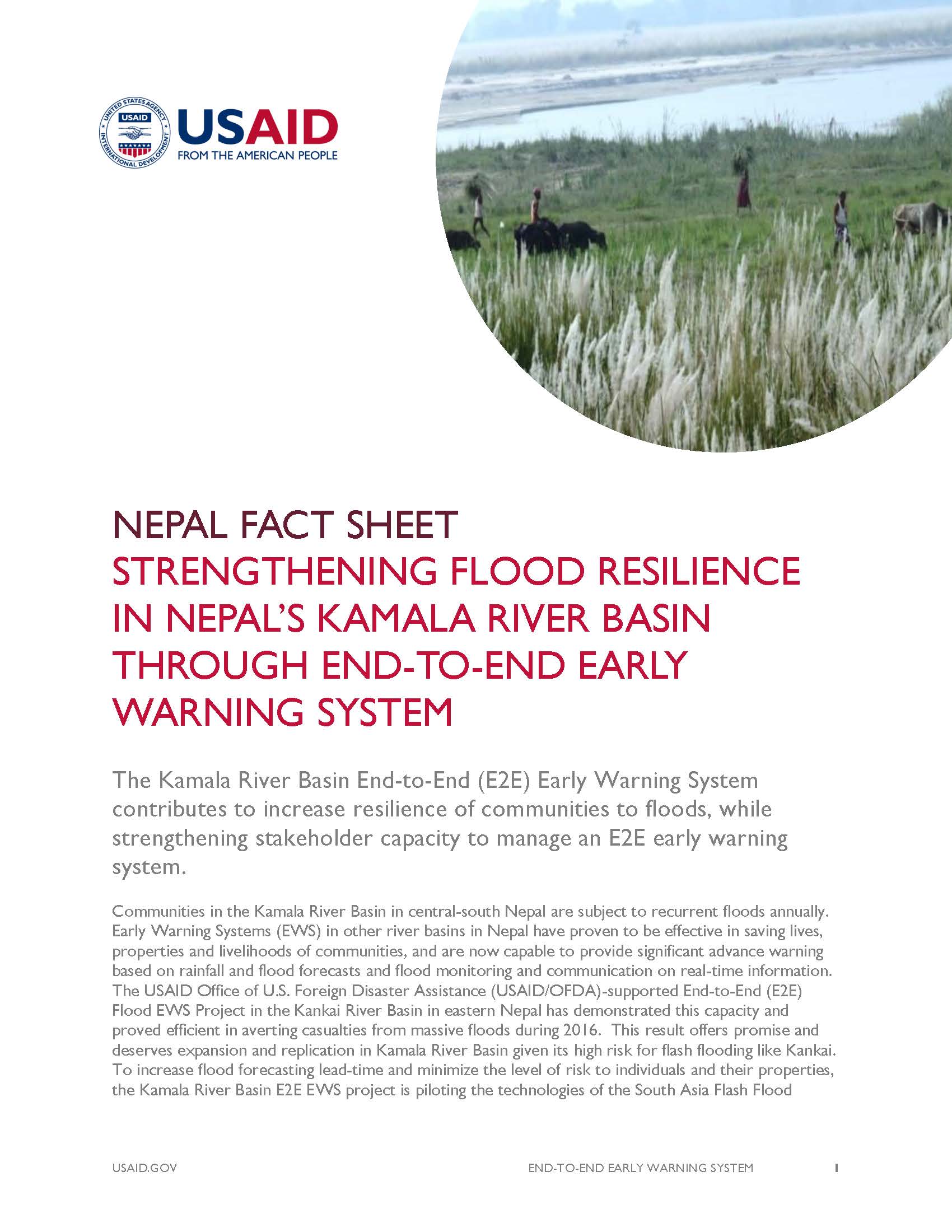Speeches Shim
The Kamala River Basin End-to-End (E2E) Early Warning System contributes to increase resilience of communities to floods, while strengthening stakeholder capacity to manage an E2E early warning system.
Communities in the Kamala River Basin in central-south Nepal are subject to recurrent floods annually. Early Warning Systems (EWS) in other river basins in Nepal have proven to be effective in saving lives, properties and livelihoods of communities, and are now capable to provide significant advance warning based on rainfall and flood forecasts and flood monitoring and communication on real-time information. The USAID Office of U.S. Foreign Disaster Assistance (USAID/OFDA)-supported End-to-End (E2E) Flood EWS Project in the Kankai River Basin in eastern Nepal has demonstrated this capacity and proved efficient in averting casualties from massive floods during 2016. This result offers promise and deserves expansion and replication in Kamala River Basin given its high risk for flash flooding like Kankai. To increase flood forecasting lead-time and minimize the level of risk to individuals and their properties, the Kamala River Basin E2E EWS project is piloting the technologies of the South Asia Flash Flood Guidance System (FFGS). As a critical EWS tool, the FFGS relies on multi-stage forecasting and monitoring and improves the depth and timeliness of information available to flood-prone communities. The “end-to-end” nature of the system also ensures that all elements of flood preparedness and response—from hazard detection to community mobilization—are emphasized.
PROJECT OVERVIEW
The project is establishing a community-centered E2E flood EWS in Kamala River Basin that enhances awareness and capacity of vulnerable communities and disaster risk reduction (DRR)-related agencies to understand, monitor, and prepare for effective flood warning and response. The project provides trainings on EWS, DRR, and integrating DRR into development planning. The project also supports formation and strengthening of flood preparedness and response institutions at vulnerable communities, respective Village Development Committee (VDC), and municipality. The project cooperates and collaborates with District Disaster Relief Committee (DDRC)stakeholders in respective districts and works with and supports Nepal’s Department of Hydrology and Meteorology (DHM) to upgrade and manage flood risk monitoring, forecasting and communication systems.
PROJECT ACTIVITIES
- Assess community risk from different flooding levels in the Kamala River Basin
- Support DHM to establish new flood and rainfall monitoring stations and upgrade existing stations for EWS set up
- Support DHM to develop and run flood forecasting, based on information gathered from rainfall monitoring
- Set up risk information communication system in the basin building on the existing national facilities
- Train communities and stakeholders to prepare for and responding to risks through the EWS
- Strengthen the capacity of the DHM in the use of FFGS technologies
- Develop and strengthen institutional networks to enhance community and stakeholder capacity to respond to flood risk information
- Develop local and district level disaster management plans that skillfully integrate EWS
PLANNED RESULTS
- 36,352 people—including 17,690 men and 18,662 women—will directly benefit from reduced hydro-meteorological hazard risks; another 189,619 people will benefit indirectly.
- Meteorological policies or procedures will be modified as a result of the activities, to increase preparedness for hydro-meteorological events.
- Flood forecasting and warning for hydro-meteorological events, including abnormal weather, heavy rainfall, and flooding, will be improved.
- Leaders and officials in relevant organizations including 50 individuals from DHM, DDCs, local government bodies and NGOs will be trained in hydro-meteorological related activities.


Comment
Make a general inquiry or suggest an improvement.